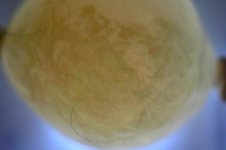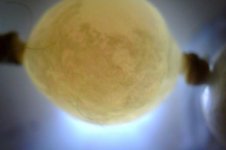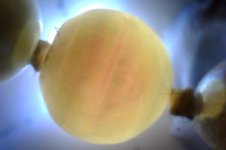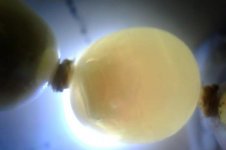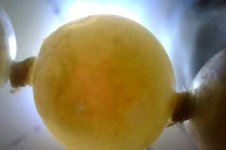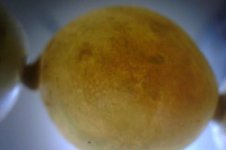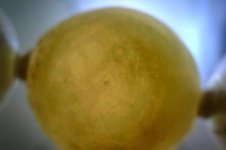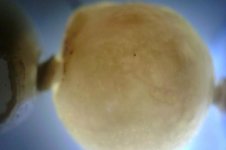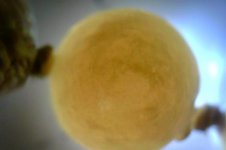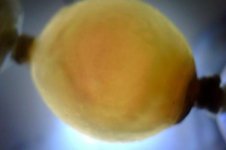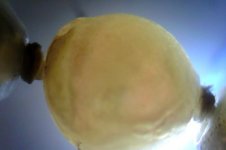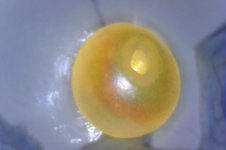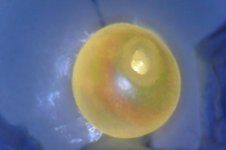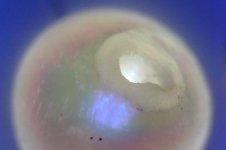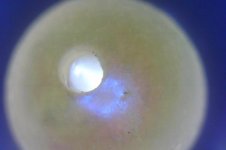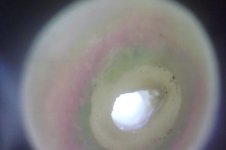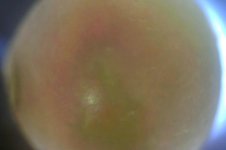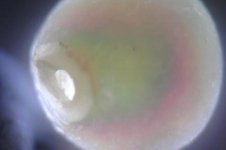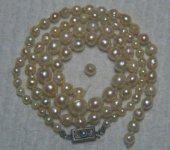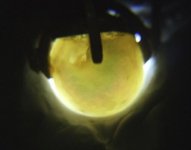Dave, are you talking about the one I used my microscope on to take a good photo of the drill hole? or is it the one that we spotted or a couple or three that we spotted. What was more what we were discussing is why the candling photos have swirls and interesting features.
I was referring to the images in post 303 in my last post. I wanted a little more time to study the views in 302. For the same reason a radiologist would looks at human x-rays, even after the attending physician gas treated the patient. The images in 302 send mixed messages. While there is some maybe in some, most appear cultured to me.
In candled views, smaller pearls will appear to have thicker nacre than larger pearls, not because it grows any faster, just that the ratio of nacre to bead will be more equalized. As such, the distinctive ring we often see at the margin will appear deeper in the hole.
Dave did you look at the smaller pearls in that bracelet and if so what did you think of them. They looked to me as if they might be naturals although it does seem odd to add naturals to a bracelet with large cultured pearls. Still smaller naturals are easier to get hold of that really good size ones.
Two of the pearls have distinct cultured features not normally seen in naturals. One presents with the concentric rings of washboard mussel nuclei. Barring that, it otherwise appears as the "circle" pearl effect we also see in cultured pearls.
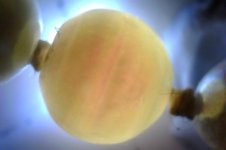
The other with the a square tissue graft. It didn't lay flat against the bead, but turned outward 90 degrees and formed a fire ball tail. The remaining pearls have some natural features, but not enough to rule them apart from cultured.
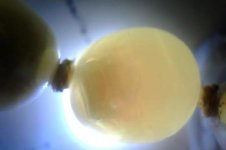
Dave, Can you tell us why they look the way they do. I am sure others would also be interested and it would help us no end when candling so we would have a chance of "reading" them ourselves instead of bothering you all the time. As Andrea said a while back she would love to study Candling as would I but as that is not possible our only source is you. You are the candling King and we do want to try and work out what we see in candling photos. But it is not easy especially when getting such confusing results in known cultured pearls.
Good questions. For starters, I may be the only person alive on the planet who has handled more natural pearls than cultured ones, so it's somewhat inherent as opposed to an acquired skillset. For the most part, they don't resemble each other at all. When there is doubt, you need to ask yourself two questions. Is this a cultured pearl that's scruffy enough to appear natural? Or, is this a natural pearl fine enough to appear cultured? Before one can even begin to address this, think of the math. Chances are it's the former bay a ratio of 10000:1. Rare the latter. This is why there are a lot of elaborate fakes out there. IMHO, even a significant number of lab certified natural pearls are indeed cultured pearls that slipped through the cracks of their criteria.
Once a pearl comes for analysis the first thing I look for is the initiating event. In naturals, these events will always be at the heart of the nucleus. Not necessarily the absolute middle and often somewhat eccentric, but rarely, if ever near the surface. As a pearl grows, it does not begin by laying up terraced aragonite. That structure only occurs once the ideal foundations are built.
Like the rings of a tree, biomineralization has an order. In most mollusks it's periostracial ---> prismatic ----> nacreous. The periostracum is mostly conchiolin while prismatic layers have very little protein. Protein then again becomes more enriched in terraced aragonite (nacre) and the crystals are highly organized. It's seasonally regulated. Shells grow rapidly in summer months and not so much in winter. In fact, shells and/or pearls can even be reabsorbed into the mantle tissues, especially during prolonged periods of lower salinity. That's a whole other realm I'll speak to in the future... ocean acidification. Shells are a terrific indicator of this phenomena.
It's these on again, off again processes that give us the impression of the unique coloration and woven or latticed patterns observed in sea shells.
These contrasts can be read by candling. No just by eye sight, though. Microscopy can differentiate these margins at a molecular level. I'm still waiting on electron microscopy work to come back from Ana at the University of Granada lab, where I've submitted amazing samples of Pododesmus macrochisma, where the difference in these margins are acute. It will be easier to explain when we see those views.
Because pearls have concentric growth, successive years will encase the previous years. There is no escaping this fact. Initiating events almost always appear as darker contrasts in candled views in nearly every case. If these events appear outside of the identified axial point, it's a cultured pearl. I use the words almost and nearly, because some pearls are not singularly initiated. On occasion, a pearl can pop from the sac and become lodged elsewhere in the animal and thus become a pearl in a pearl.
Owing to the fact most purported naturals are indeed inferior grade cultured pearls, we must preclude those features entirely before we can even begin to support natural origin.
I am seeing way too many of these steps skipped. We cannot put the cart before the horse, lest our objectivity goes out the window.
For our purposes in this thread, the simplest observation is we need to see clear layers on top of shadowed layers, not shaded layers on top of clear layers. A bead will usually appear as translucent and featureless, unless it's a washboard mussel. In which case, seasonal growth features appear as inscribed lines within a circle. Otherwise the patches we see on most of these pearls --cap the bead-- near the surface.




